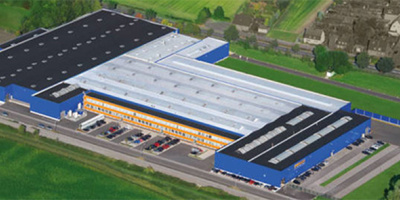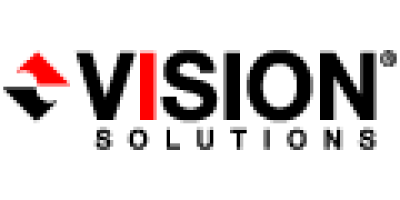Kwik Trip, Inc. is a leading convenience store chain composed of over 350 stores throughout Wisconsin, Minnesota, and Iowa. These stores operate under the brand names of Kwik Trip, Kwik Star, Hearty Platter, and Tobacco Outlet Plus. With so many stores spread throughout the midwest, tracking credit card receipts, invoices, and other accounting documents can be a real challenge. So, when Tammy Franzini, credit manager at Kwik Trip, discovered that the company's legacy document image management system wasn't keeping up with the company's growth, she turned to IT for assistance.
Ed Strahs is the director of information technology at Kwik Trip, and he runs a diverse IT department in which the IBM iSeries plays a pivotal role. It is not a simple environment, though it may be typical. It's composed of numerous Microsoft Windows PC servers networked to mission-critical applications on an IBM iSeries Model 810 computer. Kwik Trip's legacy document image management system was one of the networked systems associated with the iSeries, but it wasn't pulling its weight. That's when Strahs started looking at the options. When the initial upgrade costs of the legacy system were proposed, the expense made him pause.
Asking the Right Questions
Instead of simply accepting the upgrade proposal from the legacy system's representative, Strahs and Franzini started asking some important questions: Was the quality of the proposed upgrade really worth the expense? Shouldn't Kwik Trip also consider newer products in the marketplace, products designed to work specifically with the company's main information system on the IBM iSeries? How could the requirements of Kwik Trip's document image management system be integrated with the rest of the information requirements of the company? What would be the best set of tools to accomplish this goal? Could it be done in a more cost-effective manner?
These were just some of the questions that Strahs and Franzini started asking. Fortunately, they had heard of RJS Software Systems, and Strahs made arrangements to review the vendor's WebDocs- iSeries edition document management system.
WebDocs – iSeries Edition
WebDocs (formerly known as Image Server/400) is RJS Software's complete Web-based document image management system designed for use with the IBM AS/400, iSeries, and i5 platforms. WebDocs allows scanning, indexing, and storage of documents from a PC workstation into iSeries Integrated File System (IFS) folders.
- Document Scanning: WebDocs software will interface with any Twain-compliant scanner, allowing an easy connection to the greatest variety of high-speed scanning and document feeding equipment available on the market.
- Document Storage: By using the iSeries IFS folders as the storage medium, WebDocs provides a standardized, centralized repository for company documents that is secure and easily accessible to everyone in the organization.
- Document Retrieval: Documents stored in WebDocs can be retrieved and viewed with any Web browser, removing the need for specialized client software that many other systems require. There's no requirement for special client access licenses either. Moreover, scanned documents stored in WebDocs can be shared and/or distributed directly by fax or email.
- Document Archiving: Archiving documents for long-term storage is also simple and highly configurable with WebDocs. Documents can be saved to CD, optical disk, or remote FTP sites.
The WebDocs Value Statement
Strahs saw a three-fold advantage in RJS Software's WebDocs over the system Kwik Trip was previously using:
Faster Throughput
First of all, implementation of WebDocs would provide Franzini's department with a significant upgrade in speed and quality of her document image scanning system. Using an affordable, color, duplex flatbed scanner manufactured by Fujitsu with a 100-page-per-minute document feeder, the proposed system from RJS Software would greatly improve the scanning throughput within the credit department. In addition, the WebDocs software would provide Kwik Trip with the ability to create multiple index keys (up to 10) per scanned document, enabling better cross-indexing for faster document searches.
Simpler Access, Faster Retrieval
Secondly, WebDocs' use of the iSeries computer as the document storage medium would centralize the scanned documents, making them more readily accessible to other personnel in other departments throughout the Kwik Trip network. And since WebDocs needs no special client software, Kwik Trip users would need no special IT support to install or maintain complicated client access software. Kwik Trip users would simply use their standard Web browsers to access and display the scanned documents from anywhere in the company or its 350 stores.
In addition, when necessary, employees could fax or email scanned documents directly from their desktops, without sending the documents to printers.
Better Administration, Greater Functionality
Thirdly, WebDocs would allow Kwik Trip's entire document image management system to become an integrated part of Kwik Trip's iSeries IT infrastructure. Important financial reports created on the iSeries could be directly archived to the WebDoc's document imaging system as PDF files, without the added step of printing to paper. In addition, WebDoc's centralization of data on the iSeries would better protect the information system from unscheduled downtime while incorporating the day-to-day administration of the system into the normal operations tasks of the iSeries IT department. This integration would include beefed-up security through OS/400's security mechanisms down to the folder level, while providing better system-wide backup and recovery procedures.
Most importantly, by centralizing the document image management system on the iSeries, Kwik Trip could realize a substantial increase in the company's return on investment (ROI) by lowering the management costs associated with Kwik Trip's previous document imaging system.
All of these factors made the WebDocs system a very attractive and surprisingly affordable solution. However, other considerations faced Kwik Trip besides merely replacing the legacy system.
Beyond Basics: RJS Software Service
There are at least four basic functional requirements for any document image management system: capturing, indexing, archiving, and retrieving. But there is also an unheralded fifth element that often halts an organization from moving ahead to leverage better technologies: legacy document data conversion!
Over the years, thousands of pieces of information at Kwik Trip had been scanned, indexed, and stored in the old legacy document image system. In order to implement the new system using WebDocs, these documents would need to be transformed into new pieces of information that could be accessed and read through WebDocs.
Fortunately, Strahs discovered that RJS Software not only had a better document imaging solution, but also had the technical expertise to help Kwik Trip with the conversion. To manage the conversion, RJS Software assigned to Kwik Trip a personal technical account representative to handle the details of installation, training, and data conversion.
This was especially important to Franzini, Kwik Trip's credit department manager. "When I call them up now with a technical question or a problem, our representative is already familiar with our system and our needs. I go directly to our account rep, and she is a real person at the end of the telephone who knows what we were attempting to accomplish. Not just somebody picking up the phone at a call center."
Big Benefits, Better ROI
After weighing the costs and the benefits between upgrading the old legacy system and moving to the new iSeries-based solution, Kwik Trip chose RJS Software's WebDocs. So how did Kwik Trip's implementation go?
Today, Kwik Trip's document imaging system is in full operation. Not only has the document scanning throughput increased, but Kwik Trip's credit department is now making substantial progress in converting older physical archives of paper documents that had previously defied conversion by the legacy system.
Meanwhile, Kwik Trip's users are able to securely and quickly access any of the stored documents from the central location of the iSeries IFS, anywhere on the network among the 350 convenience stores, using a simple desktop Web browser.
Departmental users benefit by spooling important iSeries financial reports directly to the WebDocs system as PDF files where they are archived as a normal part of the organization's data workflow. This reduces the time and expense of archiving reports for historical use.
Finally, Kwik Trip's IT department maintains and secures the entire information system using the central administrative tools of the iSeries, handling security issues routinely while simultaneously implementing normal backup and recovery procedures for disaster recovery.
Great Value, Great Company
So that's the anatomy of Kwik Trip's document image management decision: well-defined requirements, good business sense, forward-thinking technology, and true cost/benefit analysis of all the options, including the costs of data conversion, training, and support services.
So now, after the system conversion, what does Franzini in the credit department think of RJS Software today? "The people at RJS Software are excellent," Tammy says. "RJS Software is a very good company to work with!"
And the cost? The WebDocs solution came in at a surprisingly reasonable price with an unusually good ROI. According to Ed, "RJS Software's [WebDocs] is a great solution and a great value for the price!"
Thomas M. Stockwell is Editor in Chief of MC Press Online, LP
For more information about RJS Software's WebDocs - iSeries edition, contact
RJS Software Systems
Contact: Cathy Allen
14041 Burnhaven Drive
Suite 120
Burnsville, MN 55337
United States
Tel: 888.RJS.SOFT / 952-898-3038
Fax: 952.898.1781
Web: www.rjssoftware.com
Email:






















 More than ever, there is a demand for IT to deliver innovation. Your IBM i has been an essential part of your business operations for years. However, your organization may struggle to maintain the current system and implement new projects. The thousands of customers we've worked with and surveyed state that expectations regarding the digital footprint and vision of the company are not aligned with the current IT environment.
More than ever, there is a demand for IT to deliver innovation. Your IBM i has been an essential part of your business operations for years. However, your organization may struggle to maintain the current system and implement new projects. The thousands of customers we've worked with and surveyed state that expectations regarding the digital footprint and vision of the company are not aligned with the current IT environment. TRY the one package that solves all your document design and printing challenges on all your platforms. Produce bar code labels, electronic forms, ad hoc reports, and RFID tags – without programming! MarkMagic is the only document design and print solution that combines report writing, WYSIWYG label and forms design, and conditional printing in one integrated product. Make sure your data survives when catastrophe hits. Request your trial now! Request Now.
TRY the one package that solves all your document design and printing challenges on all your platforms. Produce bar code labels, electronic forms, ad hoc reports, and RFID tags – without programming! MarkMagic is the only document design and print solution that combines report writing, WYSIWYG label and forms design, and conditional printing in one integrated product. Make sure your data survives when catastrophe hits. Request your trial now! Request Now. Forms of ransomware has been around for over 30 years, and with more and more organizations suffering attacks each year, it continues to endure. What has made ransomware such a durable threat and what is the best way to combat it? In order to prevent ransomware, organizations must first understand how it works.
Forms of ransomware has been around for over 30 years, and with more and more organizations suffering attacks each year, it continues to endure. What has made ransomware such a durable threat and what is the best way to combat it? In order to prevent ransomware, organizations must first understand how it works. Disaster protection is vital to every business. Yet, it often consists of patched together procedures that are prone to error. From automatic backups to data encryption to media management, Robot automates the routine (yet often complex) tasks of iSeries backup and recovery, saving you time and money and making the process safer and more reliable. Automate your backups with the Robot Backup and Recovery Solution. Key features include:
Disaster protection is vital to every business. Yet, it often consists of patched together procedures that are prone to error. From automatic backups to data encryption to media management, Robot automates the routine (yet often complex) tasks of iSeries backup and recovery, saving you time and money and making the process safer and more reliable. Automate your backups with the Robot Backup and Recovery Solution. Key features include: Business users want new applications now. Market and regulatory pressures require faster application updates and delivery into production. Your IBM i developers may be approaching retirement, and you see no sure way to fill their positions with experienced developers. In addition, you may be caught between maintaining your existing applications and the uncertainty of moving to something new.
Business users want new applications now. Market and regulatory pressures require faster application updates and delivery into production. Your IBM i developers may be approaching retirement, and you see no sure way to fill their positions with experienced developers. In addition, you may be caught between maintaining your existing applications and the uncertainty of moving to something new. IT managers hoping to find new IBM i talent are discovering that the pool of experienced RPG programmers and operators or administrators with intimate knowledge of the operating system and the applications that run on it is small. This begs the question: How will you manage the platform that supports such a big part of your business? This guide offers strategies and software suggestions to help you plan IT staffing and resources and smooth the transition after your AS/400 talent retires. Read on to learn:
IT managers hoping to find new IBM i talent are discovering that the pool of experienced RPG programmers and operators or administrators with intimate knowledge of the operating system and the applications that run on it is small. This begs the question: How will you manage the platform that supports such a big part of your business? This guide offers strategies and software suggestions to help you plan IT staffing and resources and smooth the transition after your AS/400 talent retires. Read on to learn:
LATEST COMMENTS
MC Press Online